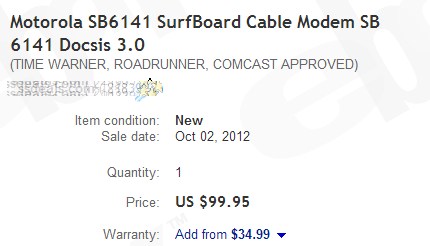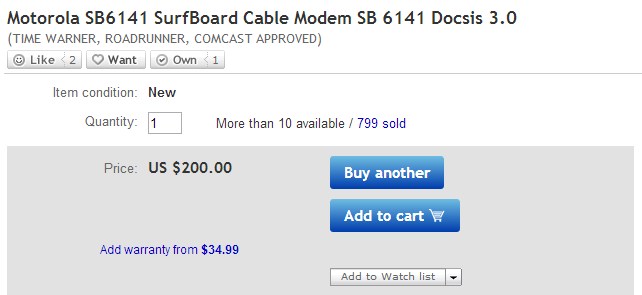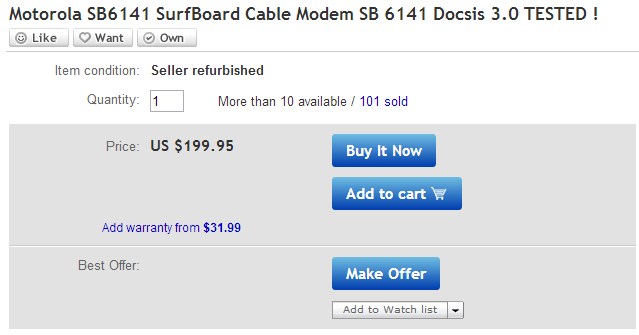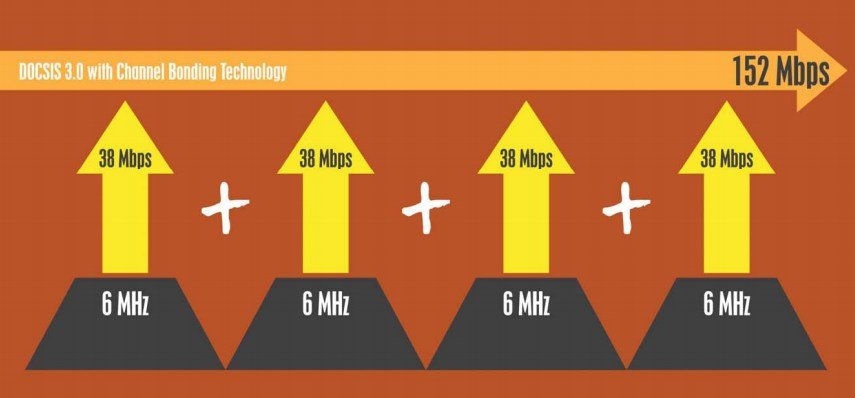
Let the gouging begin. Here was the price being charged by an eBay vendor this past Tuesday for the SB6141 cable modem.
A few days ago, Stop the Cap! notified readers Time Warner Cable was planning to charge a $3.95/mo modem rental fee for current High Speed Internet customers planning to keep using company-supplied equipment.
With over $300 million in potential new revenue, this new surcharge from the folks living high on 1% Mountain is guaranteed to make the cable company a tidy sum for doing… absolutely nothing. Time Warner is not improving your broadband service — they are just charging you separately for a piece of equipment needed to use the service you already paid for. It would be like selling you a lamp and then start charging an extra monthly fee to keep the power cord.
We’ve had our own illuminating experience here at Stop the Cap! headquarters finding our way around this newest surcharge — by purchasing our own DOCSIS 3 cable modem and sending the soon-to-be $47.40 a year (until the end of time) Ubee modem packing back to Time Warner. Only we can’t.
I am unsure what bothers me more: Time Warner’s scanty “approved modems for purchase list” — mostly Cadillac-priced models that would fit in at Barney’s New York or Nordstrom, the bottom feeder eBay and Amazon Marketplace sellers who are capitalizing on the modem fee by increasing their prices for customer-owned equipment to gouging levels, or Time Warner’s failure to activate customer-purchased modems because it “changed its billing system this week” in preparation for the new modem fees “and can’t activate customer owned modems at the moment.”

As Time Warner Cable customers began ordering the SB6141 online, the price doubled. This is the same vendor that charged $99.95 two days earlier.
Out of the five “approved” models, the obvious best choice for those who do not require a modem-router combination is the Motorola SurfBoard SB6141 DOCSIS 3.0 Cable Modem. It features support for 8×4 DOCSIS 3 channels, which in non-technical terms means it will handle the best speeds Time Warner is likely to offer in the foreseeable future. We do not recommend customers invest in DOCSIS 2 modems, because that technology is closer to the end of its useful life and simply will not support broadband speeds customers will crave in the next few years.
Once Time Warner Cable made the announcement, the race was on… for the handful of online retailers carrying the SB6141 to jack up the price as quickly as possible. I predicted this was likely in the comment section of our earlier piece. When the nation’s second largest cable operator plans to subject millions of broadband customers to unnecessary modem rental fees and smart customers are clever enough to avoid them, demand is going to rise. Prices would rise much faster.
In the last 48 hours, the cost of the SB6141 has literally doubled from $99 to $200 thanks to some eBay sellers looking for quick profits. This unit is now barely available from Amazon.com Marketplace vendors, typically with a waiting list, for around $130. It was selling for as little as $89 just a few weeks earlier. We even found some refurbished units on eBay that formerly sold for less than $100 now selling for $199, just after Time Warner’s new fee hit the media.

Buying a refurbished unit won’t save you much. Two days ago, this eBay vendor was charging $100 for the same used cable modem.
Finding retailers for this particular model has proven difficult and because of the relentless price gouging, we are now recommending customers hold off on buying their cable modems, at least until Time Warner expands their list of approved models or a broader number of retailers start selling the model to help force prices back down to earth. Don’t pay an eBay gouger twice the usual price!
For customers who mistakenly ended up buying our earlier recommended model we quickly crossed off the list (the SB6121), we’ve found Amazon.com especially accommodating, even supplying a prepaid return shipping label, after explaining the modem model mess to Amazon’s customer service and requesting a free return. So yes, we got stuck with the wrong model too. Sending the 6121 back is our best recommendation as Time Warner Cable customer service explained as late as this evening they cannot activate customer-owned equipment not on their approved-for-purchase list (or anything else at the moment).
Our second order, for the SB6141 at the pre-gouge price of $99 arrived this afternoon, and that led to more frustration with Time Warner Cable, who ultimately failed to activate the modem.
After a very lengthy hold time, a Time Warner representative took my modem’s MAC address to activate the device, and it failed to register. A supervisor eventually explained Time Warner Cable updated their billing system to accommodate the forthcoming modem rental charge and in the process brought down the customer-owned equipment activation system (the one that will let Time Warner know who will not have to pay the fee) earlier this week. In other words, while adjusting their billing system to charge you more, a “glitch” made it impossible for customers across the eastern United States to prevent that from happening.
The problem, it was explained, was temporary and they expected to fix it by the end of the week. After explaining today is Thursday (the end of the week is already near), I was told to “call back this weekend or Monday” and “hopefully” the problem would be fixed. Hopefully before October 15th, when the fee kicks in for the Big Apple anyway. That was 40 minutes of my life I will never get back.
One would think if Time Warner was planning to throw a Money Party for themselves, they would at least take some of the forthcoming $300 million to invest in a better way to keep customers from long hold times and inconvenience to avoid the latest unnecessary fee, only to be told everything was broken and to call back some other time. This is why cable companies regularly earn the disdain of their customers.
 Time Warner Cable will increase the broadband speed for its most popular Standard service to 15/1Mbps across the country over the next 60 days.
Time Warner Cable will increase the broadband speed for its most popular Standard service to 15/1Mbps across the country over the next 60 days.

 Subscribe
Subscribe





